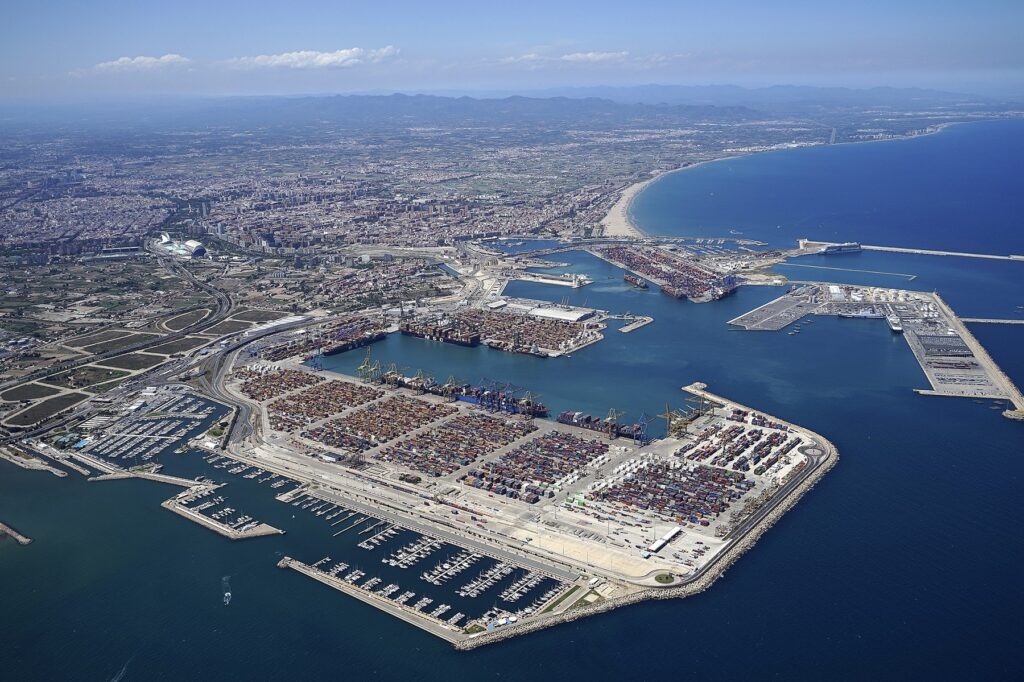Valencia handles traffic of practically all types of goods from every sector of the economy. The main customers of the Port of Valencia include: the furniture and timber industries, textiles, footwear, agriculture and foodstuffs (grain and fodder, wine and beverages, tinned food, fruit, etc.), fuel products (diesel fuel, petrol, coal, etc.), chemical and motor vehicles (Ford, Fiat, Land Rover, Jaguar, etc.), the construction industry (cement and clinker, ceramic tiles, marble, etc.), machinery, etc.
The Port of Valencia also has regular passenger traffic to and from the Balearic Islands and Italy. In recent years the Port of Valencia has experienced a continued and solid growth in Mediterranean cruise traffic.

Consulta la información meteorológica del Puerto de Valencia.
History
The coastline in the Gulf of Valencia, lacking natural shelters or harbours, was a serious obstacle to the development commercial sea trade. Despite this, there are references to these activities dating back to the 6th century BC. But it is much later, as a consequence of a privilege dispensed on 17 March 1491 to the Valencian nobleman Antoni Joan by King Ferdinand the Catholic that we can establish the first historical reference to port operations in this area. From those days on, the economic endeavours of the Valencians brought about a growing commercial port, which led King Pedro III of Aragón to grant to Valencia the establishment of a maritime and commercial jurisdiction known as the Consolat de Mar. In the second half of the 15th century, Valencia had a population of 75,000 and was the largest city on the Iberian Peninsula. Its port was of major importance to the to the Crown of Aragón, with shipping lines to ports in Italy, Western Europe and Northern Africa.
In 1985, In 1985, ensuing from Royal Decree 2100, the ports of Sagunto and Gandía, were integrated within the administrative domain of the erstwhile Autonomous Port of Valencia, known today as the Port Authority of Valencia.
History
The history of the Port of Valencia began in 1483, when King Ferdinand the Catholic granted a certain Antoni Joan the privilege of building a wooden bridge on the beach of the Grao district, called the “Pont de Fusta”.
As of this date, until the 19th C, various projects for the construction and improvement of these facilities were carried out, without ever being too successful due to the periodic flooding of the Turia river and the continual movements of sand on the beach. Yet traffic increased to quite an extent, and trading privileges were granted for commerce with other kingdoms in 1679 and for the Americas in 1791, with Valencia becoming the sixth maritime province in Spain.
Throughout the 20th century, improvement works were made to buildings and warehouses and the extension of the quays was continued with the current configuration being achieved, and specialised facilities being created for all types of goods. These extensions, closely linked to the rise in container traffic in recent years, have enabled Valenciaport to achieve its current position of leadership among trading ports on the western Mediterranean. Currently, the Port of Valencia is executing an extension plan that will enable it to handle container traffic of up to 10 million TEUs, with state-of-the-art facilities for tourist cruiser traffic as well.
In relation to the management of the port, as of 1880 this was entrusted to the so-called “Junta de Obras del Puerto de Valencia” (Works Committee of the Port of Valencia), a body that was replaced by the “Junta del Puerto de Valencia” (Valencia Port Committee) in 1968. With the granting of Valencia’s statute of autonomy in 1978, management of the port was transferred to the Autonomous Port of Valencia, but when the Ports Act was published in 1992, it changed its former name to become known by its current denomination Port Authority of Valencia.

